LED Module
How to Install LED Cove Lighting
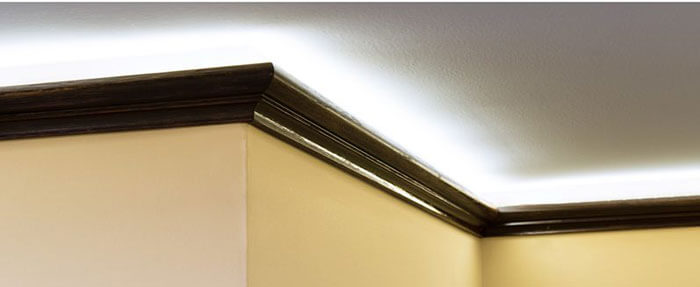

LED cove lighting is a great way to add accent lighting or color to any room, and LED strip lights are the perfect product for the job. LED strip lights can be used for any type of cove—whether it was built in with your home or a DIY project. There are many different options to choose from. With RGB LED strip lights, you can choose from a ton of dynamic color-changing and single-color modes with adjustable brightness and speed control. Single-color and variable color temperature strips are also available and can be used with a compatible controller and remote. Installing LED cove lighting is easy, and we’ve provided basic instructions for a standard L cove, recessed ceiling/tray ceiling cove, or crown molding cove in a 16-by-16-foot room. We recommend that you have a certified electrician wire your strip lights to power.
Materials:
RGB LED Strip Lights – 16-foot runs
RGB LED Controller with Touch Remote control
12VDC 200-Watt LED Power Supply
RGB LED Amplifiers
Female LC4 Locking Connector Pigtail Power Cables
Male LC4 Locking Connector Pigtail Power Cables
3M Double-Sided Foam Pad
24-18 AWG Dual-Channel Wire Splice Connectors
24-18 AWG Single-Channel Wire Splice Connectors
18-Gauge Two-Conductor Power Wire
Tools and Optional Materials:
Wire Strippers
Wire Nuts
Electrical Tape
1.Before ordering your LED strip lights, measure the length of cove on each side of your room and add the lengths together; this number indicates the total length of strip that you will need. A 16-by-16-foot room would require four runs of the 16-foot RGB LED strip light used in this installation. You will also need to measure the distance between where your power supply will be and both corners where the amplifiers will be installed (see the setup and wiring illustration in step 5). Another important measurement is the distance that will be between the power supply and the controller. Make sure to account for the distance of any turns that the wires may take along their paths. These distances will tell you how much 18-gauge wire you’ll need for connecting the amplifiers to power and for connecting the controller to the power supply. Additional required measurements are listed in step 2. Whether or not you need amplifiers depends on the size of your room and maximum run of the strip you choose. If you connect more than the maximum run of strips together, they will be noticeably dimmer toward the end. Many single-color strip lights could be used in a 16-by-16-foot room without them. A 24-volt strip is also more likely to have a longer maximum run.
2.Before you’re ready to install your LED strip lights, locate where you will be connecting your power supply to electricity and measure that distance. If you use the strips and controller used in these instructions, you can dim them with the included remote. However, if you want to wire the controller to a 110-volt dimmer switch, you will want to either mount your controller as close as possible to it or account for the distance and order extra two-conductor power wire. You will also need a dimmable power supply for that type of installation. We recommend having a certified electrician wire your strip lights after you set them up. Do not attempt to connect to power until the installation is complete.
3.Connect your RGB LED controller to the power supply using a run of 18-gauge two-conductor wire. You will need to strip back the wires so that they make proper contact with the controller and power supply terminals.
4.Use female LC4 pigtail power cables to connect your first two RGB LED strip lights to the controller. Connect both sets of pigtail adapter wire to the controller, and plug the other end of each adapter into the male LC4 connector on each strip.
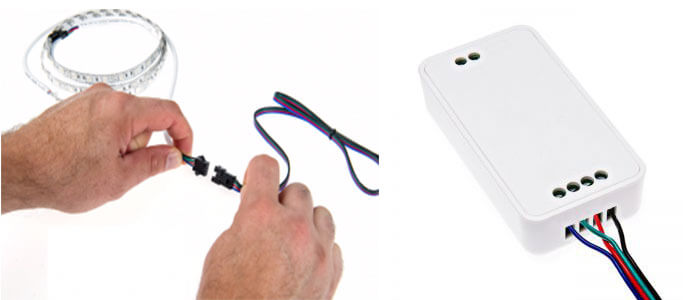
*Note that you can always cut the LC4 connectors off of the strips, strip back the insulation, and connect the strip wires directly to the controller or amplifier (can be done anytime in this installation instead of using a female or male pigtail power cable).
5.You will apply strip 1 clockwise around the inside of your cove and strip 2 counterclockwise. It is up to you to decide which way your strips will face. We recommend using masking tape to hold your strips in place before removing their backings. This will enable you to achieve your desired cove lighting effect.
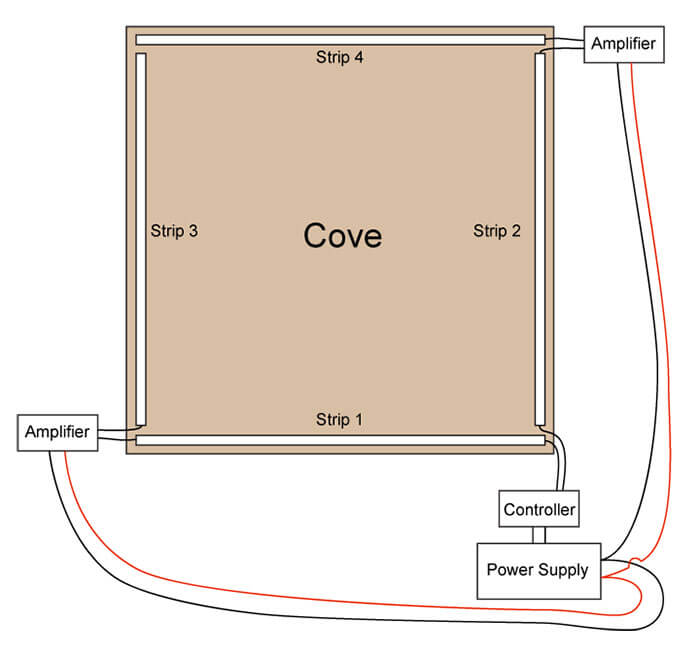
The way you install the strips or even the number of strips used might vary depending on the room size or the style, shape, and size of your cove. The steps and materials needed for this particular installation could be used in a room with a standard L cove, crown molding cove, or recessed ceiling/tray ceiling cove. The photos below show several different cove types.
Types of Coves:
DIY “L” Cove
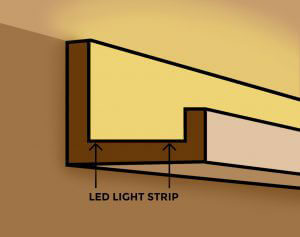
Coffered Ceiling Cove
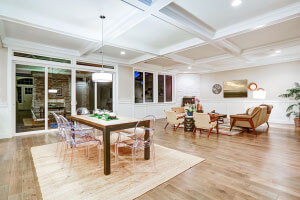
Valence Cove
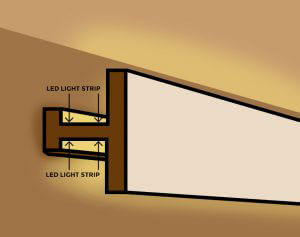
Recessed Ceiling/Tray Ceiling Cove
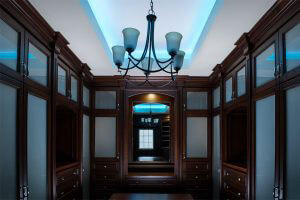
Crown Molding Cove
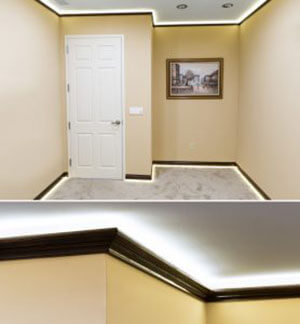
6.Once you’ve mounted strips 1 and 2, you will need to connect them to amplifiers at opposing corners of the room. Use a male LC4 pigtail power cable to connect strip 1 to the adapter that’s included with the amplifier.
Using 24-18 AWG Single-Channel Wire Splice Connectors (one for each color wire), join each like-colored wire on the LC4 pigtail power cable to the same color on one end of the amplifier’s adapter. Plug the adapter into the amplifier. Do the same when connecting strip 3 to the other side of the amplifier. You will be using a female LC4 pigtail power cable to connect strip 3 to the amplifier’s adapter. The separate black and red wires on the amplifier are meant to be connected to the power supply (explained in step 7).
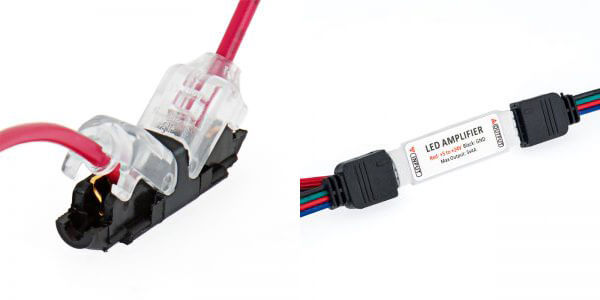
7.Use 18-gauge two-conductor wire to connect the amplifiers to your power supply. Insert the amplifier’s red and black power wires into a 24-18 AWG Dual-Channel Wire Splice Connector and your additional run of 18-gauge wire into the channels on the other side of the connector. Insert the 18-gauge wire into the appropriate terminals on your power supply.
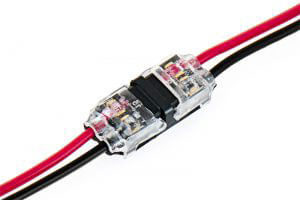
8.If desired, use a double-sided 3M foam pad to mount the amplifier in the middle of strips 1 and 3. Cut the foam pad, and use it for both amplifiers.
9.Repeat steps 6-8 for strips 2 and 4.
10.If you are experienced, connect your power supply to power. Otherwise, hire a certified electrician to set up power for your new LED cove lighting.
For more LED cove lighting options, see our entire selection of LED strip lights. Please note that each installation is unique. The required materials will vary based on the length of the area or room, the specific strip, how you will connect to power, and if you choose to control your strips with a wall dimmer.
- Preview:Easy step for LED Sign Lighting
- Next:COB LED Module